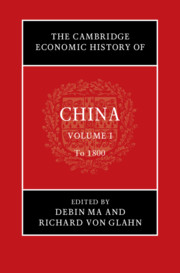Book contents
- The Cambridge Economic History of China
- The Cambridge Economic History of China
- The Cambridge Economic History of China
- Copyright page
- Contents
- Figures
- Maps
- Tables
- Contributors to Volume I
- Acknowledgments
- Note on Citations
- Introduction to Volume I
- Part I Before 1000
- 1 The Economy of Late Pre-imperial China
- 2 Agriculture and Its Environmental Impact
- 3 State and Economy
- 4 Money, Markets, and Merchants
- 5 Economic Philosophy and Political Economy
- 6 Silk Road Trade and Foreign Economic Influences
- Interlude
- Part II 1000 to 1800
- Bibliography of Primary Works Cited
- Index
- References
4 - Money, Markets, and Merchants
from Part I - Before 1000
Published online by Cambridge University Press: 07 February 2022
- The Cambridge Economic History of China
- The Cambridge Economic History of China
- The Cambridge Economic History of China
- Copyright page
- Contents
- Figures
- Maps
- Tables
- Contributors to Volume I
- Acknowledgments
- Note on Citations
- Introduction to Volume I
- Part I Before 1000
- 1 The Economy of Late Pre-imperial China
- 2 Agriculture and Its Environmental Impact
- 3 State and Economy
- 4 Money, Markets, and Merchants
- 5 Economic Philosophy and Political Economy
- 6 Silk Road Trade and Foreign Economic Influences
- Interlude
- Part II 1000 to 1800
- Bibliography of Primary Works Cited
- Index
- References
Summary
Metallic coinage, markets, and private merchants appeared in China during the Spring and Autumn era (771–453 bce), and they expanded rapidly during the Warring States era (453–221 bce). These periods were marked not only by rapid economic progress, but also by new conceptualizations of money, markets, and merchants. Both in times of political stability such as the Qin, Han, Sui, and Tang dynasties, and in times of political disunion such as the Warring States, the Three Kingdoms, the Jin, and the Northern and Southern Dynasties eras, money, markets, and merchants performed important economic and social roles. Which kinds of goods, then, served a monetary function from the Warring States to the Tang period? How did people use money, and how and where did they buy and sell commodities? What was the relationship between private merchants and governments? In this chapter, these issues will be examined using transmitted documentary records, archaeological materials, numismatic findings, and recently excavated texts.
- Type
- Chapter
- Information
- The Cambridge Economic History of China , pp. 131 - 165Publisher: Cambridge University PressPrint publication year: 2022



